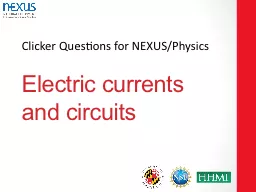

Is it possible to light a bulb with a battery using only one wire Yes No I have no idea NEXUSPhysics Clicker Questions Which of the arrangements shown will light the bulb Only A Only B ID: 569912
Download Presentation The PPT/PDF document "Electric currents and circuits" is the property of its rightful owner. Permission is granted to download and print the materials on this web site for personal, non-commercial use only, and to display it on your personal computer provided you do not modify the materials and that you retain all copyright notices contained in the materials. By downloading content from our website, you accept the terms of this agreement.
Slide1
Electric currents and circuitsSlide2
Is it possible to light a bulb
with a battery using only one wire?
YesNoI have no idea
NEXUS/Physics Clicker QuestionsSlide3
Which of the arrangements shown
will light the bulb?
Only AOnly B
Only C
Only D
Only EOnly FA & CB & FD & E
NEXUS/Physics Clicker QuestionsSlide4
In the two cases shown here a battery is connected
to a box containing some identical bulbs. The
battery maintains a constant potential difference
V
0. across its terminals. Which bulbs will be brighter?
A in #1
B in #1
A and B in #1 (equal)
A in #2B in #2A and B in #2 (equal)All 4 equalOther
NEXUS/Physics Clicker QuestionsSlide5
Charge flows through a light bulb.
Suppose a
wire is connected across the bulb as shown. When the wire is connected, all the charge continues to flow through the
bulb
.
half the charge flows through the wire, the other half continues through the bulb.all the charge flows through the wire.none of the aboveSlide6
This circuit has two identical light bulbs burning with equal brightness and a single 12 V battery. When the switch is closed,
the
brightness of bulb A
increases
decreases
decreases to 0remains the same
NEXUS/Physics Clicker QuestionsSlide7
This circuit has two identical light bulbs burning with equal brightness and a single 12 V battery. When the switch is closed,
the
brightness of bulb B
increases
decreases
decreases to 0remains the same
NEXUS/Physics Clicker QuestionsSlide8
Which of the bulbs in the following
circuit is (are) the brightest?
AB
C
D
B and CA and DSomething elseYou can’t tell from the information givenNEXUS/Physics Clicker QuestionsSlide9
Sample Problem
How do the currents in resistors A and B compare?
How do the voltage drops across resistors A and B compare?
How does the current in and voltage drop across resistor C compare to those
in
A and B?Find the current in resistor D.
(
R
)
(
R
)
(2
R
)
(3
R
)
(
V
0
)
I
0
= V
0
/
R
NEXUS/Physics Clicker QuestionsSlide10
Sample Problem
If bulb D is removed from its socket, how does the brightness of the three bulbs A, B, and C change?
(
R
)
(
R
)
(2
R
)
(3
R
)
(
V
0
)
I
0
= V
0
/
R
NEXUS/Physics Clicker QuestionsSlide11
Sample
Problem
If bulb D is put back in its socket, and now bulb C is removed, rank the brightness of the three bulbs A, B, and D?
(
R
)
(
R
)
(2
R
)
(3
R
)
(
V
0
)
I
0
= V
0
/
R
NEXUS/Physics Clicker QuestionsSlide12
Use
Kirchhoff's principles
to find: the current through each of the bulbs and
the current
through
each of the batteries.#1 = 6V#2 = 3VA = B = C = 3ΩNEXUS/Physics Clicker QuestionsSlide13
What
can you say about the voltage
at the points A, B, and C? The
magnitudes of the voltages at A and B add up to the magnitude of the voltage at C.
The
sum of the magnitudes of the voltages at two of the points adds up to the magnitude of the voltage at the third (but we can’t say which).The magnitude of the voltages at all three points are equal.There is not enough information to draw any of the above conclusions.Something else. Slide14
What can you say about the currents
at
the points A, B, and C? The magnitudes of the currents flowing through A and B add up to the magnitude of the current flowing through C.
The
sum of the magnitudes of the
currents at B and C add up to the magnitude of the current through A.The sum of the magnitudes of the currents at A and C add up to the magnitude of the current through B.The magnitude of the currents flowing through all three points are equal.There is not enough information
to draw any of the above conclusions.Something else Slide15
In what direction is the current
at
point C flowing? To the left.To the right.
It
is zero.
There is not enough information to draw any of the above conclusions.Something else. Slide16
What can you say about the voltage at the point C given that
we
take the voltage at the bottom of the battery to be 0?(V0 = 9 V; R = 3 Ω )
It
is zero.
It 9 Volts.It is 3 Volts.It is 4.5 Volts.There is not enough information to draw any of the above conclusions.Something else.